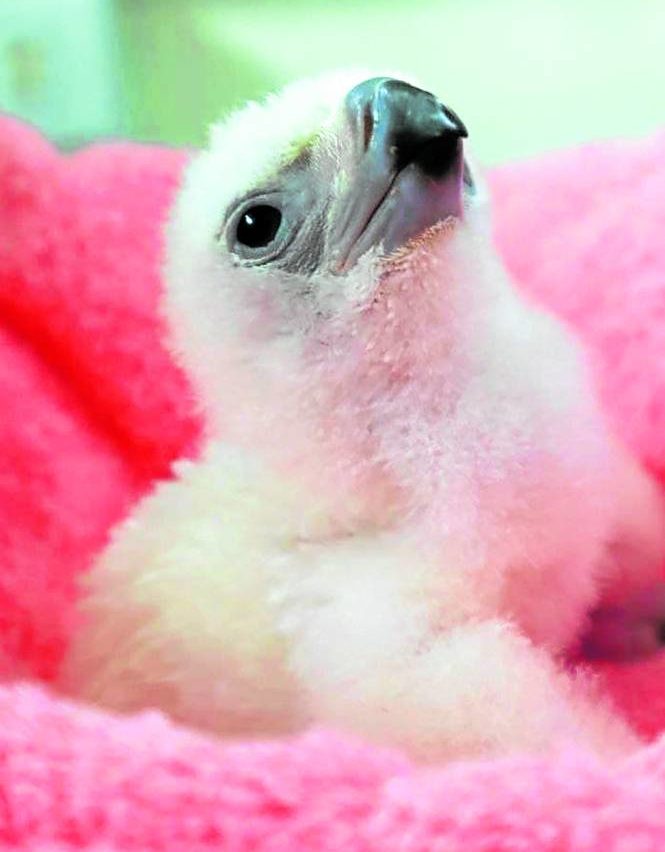
‘A CHRISTMAS GIFT’: That’s how an official of the Philippine Eagle Foundation (PEF) described
the new raptor that was hatched on Dec. 4 at the Philippine Eagle Center in Malagos, Davao City. —PHOTO COURTESY OF PEF
TANDAG CITY, Surigao del Sur, Philippines — A raptor was recently hatched at the conservation facility of the Philippine Eagle Foundation (PEF) in Davao City, the 29th chick produced since 1992.
“This is a Christmas gift … to everyone. This is a huge addition to the dwindling population of our critically endangered Philippine eagle,” Dr. Jayson Ibañez, PEF director for research and conservation, told the Inquirer by phone.
The milestone occurred even as an eagle-nesting site in Salaysay, Davao City, is being threatened by the issuance of the Department of Environment and Natural Resources (DENR) of a permit to cut 121 old-growth trees, eliciting loud protest from environmentalists.
The PEF said “Chick 29” was hatched on Dec. 4 at 1:16 p.m. It is the offspring of Ariela and MVP Matatag, both rescued eagles with disabilities and hence yet to be released to the wild.
Ariela and MVP Matatag were first brought together in February 2019 and soon became one of three natural pairs at the Philippine Eagle Center (PEC) in Malagos, also in Davao City.
Ariela laid a fertile egg on Oct. 10.
The hatching process “took 25 hours and 13 minutes since [the chick] first poked its beak and cracked the egg,” PEF said, adding that it was the fastest pip-to-hatch period on record in its breeding program.
“This is something we should celebrate and should give us more hope in the years to come,” Ibañez said.
400 pairs in the wild
There are now only 400 pairs of the Philippine eagle (Pithecophaga jefferyi), the country’s national bird, in the wild. The International Union for Conservation of Nature classifies it as an endangered species.
Ariela was adopted by Ariela Marketing Company Inc. in 2015, and MVP Matatag by PLDT in 2017, per PEF. Such sponsorships sustain the foundation’s resources for its conservation breeding program.
Captive breeding is done through natural pairing or cooperative artificial insemination. In natural pairing, male and female raptors are brought together in an enclosure with a partition made of cyclone wire. They are deemed compatible if they do not display aggressive behavior toward each other.
If they engage in courtship rituals like offering each other food and sprigs, they are moved to an enclosure with no partition so they can bond and copulate and become lifelong mates.
Eagles can live up to 40 years.
Of the 28 captive-bred eagles in the PEC before Chick 29 was hatched, only three—all male—had been released to the wild. Two eventually died and the third was returned to the facility.
The PEF is working to produce captive-bred eagles that behave like those in the wild and are healthy and fit to thrive there, the foundation said in its website.
Open letter
“Pag-asa” (the Filipino word for hope), the first raptor bred in captivity through artificial insemination, died on Jan. 6 due to infections. It was nine days short of turning 29.
Before the hatching of Chick 29, 6-year-old “Sinag,” an eagle adopted by Philippine Airlines, was the youngest raptor in PEC.
American scientist James W. Grier, the “midwife” during Pag-asa’s hatching in 1992, has joined environmentalists in calling for the protection of the Mt. Makabol forest where the Philippine Eagle has been nesting for almost four decades.
Grier, professor emeritus at North Dakota State University’s Department of Biological Sciences and adviser to PEF, has written an open letter backing calls for the revocation of the permit issued to a landowner in Salaysay to cut 121 old-growth trees in the forest.
He said the Makabol area should be left to its “natural state” as much as possible, “including leaving old and even fallen trees naturally in place.”
‘A living treasure’
In the letter addressed to DENR Regional Executive Director Bagani Fidel Evasco, Grier said he was planning to recommend the Makabol area as a United Nations Educational, Scientific and Cultural Organization World Heritage Site. He said the move would not only protect the eagles and other fauna and flora but would also uplift the well-being of the communities in the area.
“You have one of the best national birds in the world. Unfortunately, it also is the rarest and most endangered eagle in the world. It is a living treasure of the world that needs all the care and proper attention possible,” said the scientist, who described himself as a member of the original nationwide working group for the conservation of the Philippine eagle.
He said he had seen and signed the petition to cancel the tree-cutting permit at Salaysay and agreed with the documents circulated along with the petition.
‘Hope Diamond’
Grier was among the first foreign scientists to travel to the Philippines to study the nesting eagles in Salaysay. He helped develop the captive breeding techniques for the eagle species.
“Your eagle is not only a treasured species … for your country but also for the whole world,” Grier wrote. He said he had long considered the Philippine eagle the “Hope Diamond” among birds in general and eagles in particular.
“It is the reason the first Philippine eagle to be bred in captivity was named Pagasa!” he said.
It was Grier’s experience with both wild and captive eagles of other species that eventually led to his recruitment in 1977 to help with field studies of wild eagles and the captive breeding of Philippine eagles. He also helped obtain grants to help the Philippine eagle conservation efforts in the country.